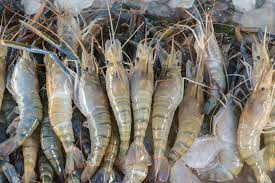Economy
Aquaculture Crop Insurance
- 07 Nov 2023
- 7 min read
For Prelims: Aquaculture Crop Insurance, Pradhan Mantri Matsya Sampada Yojana (PMMSY) scheme, Shrimp farming, Fisheries and Aquaculture Infrastructure Development Fund (FIDF), Blue Revolution.
For Mains: Aquaculture Crop Insurance, its Need and Challenges, Major crops cropping patterns in various parts of the country.
Why in the News?
Recently, the Ministry of Fisheries, Animal Husbandry & Dairying has discussed the technical challenges in the implementation of the Aquaculture Crop Insurance scheme for Shrimp and Fish farming under the Pradhan Mantri Matsya Sampada Yojana (PMMSY) scheme.
- To mitigate the risks faced by aqua farmers, NFDB (National Fisheries Development Board), which is the nodal agency for implementation of PMMSY, proposeed to implement the Aquaculture Crop Insurance scheme.
- The Scheme aims to provide basic cover for brackish water shrimp and fish on pilot basis for one year in the selected States of Andhra Pradesh, Bihar, Gujarat, Madhya Pradesh and Odisha.
What is Aquaculture?
- About:
- The term aquaculture broadly refers to the cultivation of aquatic organisms in controlled aquatic environments for any commercial, recreational or public purpose.
- The breeding, rearing and harvesting of plants and animals takes place in all types of water environments including ponds, rivers, lakes, the ocean and man-made “closed” systems on land.
- Purposes:
- Food production for human consumption,
- Rebuilding of populations of threatened and endangered species,
- Habitat restoration,
- Wild stock enhancement,
- Production of baitfish, and
- Fish culture for zoos and aquariums.
Note
Shrimp farming is an aquaculture-based activity in marine or freshwater environments to produce shrimp for human consumption.
- The estimated brackish water area suitable for undertaking shrimp cultivation in India is around 11.91 lakhs hectare (ha) spread over 10 states and union territories viz; West Bengal, Orissa, Andhra Pradesh, Tamil Nadu, Pondicherry, Kerala, Karnataka, Goa, Maharashtra and Gujarat.
- Of this only around 1.2 lakhs ha are under shrimp farming now and hence a lot of scope exists for entrepreneurs to venture into this field of activity.
What is the Need for Aquaculture Insurance?
- Aquaculture Insurance:
- Aquaculture insurance is a type of insurance specifically designed to provide coverage and financial protection to individuals or entities involved in aquaculture, which is the farming of aquatic organisms, such as fish, shrimp, and other aquatic species, for commercial purposes.
- This type of insurance is tailored to address the unique risks and challenges faced by aquaculture operations.
- Need for Aquaculture Insurance:
- Risk Management:
- Aquaculture is susceptible to various risks, including diseases, adverse weather conditions, water quality issues, and natural disasters.
- These risks can lead to significant financial losses for aquaculture farmers. Insurance helps manage and mitigate these risks by providing financial compensation in the event of such adverse events.
- Investment Protection:
- Insurance safeguards substantial investments in infrastructure, ensuring that the financial resources put into the operation are protected against unforeseen events.
- Market Confidence:
- The availability of aquaculture insurance can boost investor and farmer confidence in the industry and encourage individuals to invest in aquaculture and expand their operations.
- Sustainability:
- Insurance can promote the sustainability of aquaculture operations by providing a means to recover from unexpected setbacks, this, in turn, can encourage responsible and sustainable practices in aquaculture to reduce risks and insurance premiums.
- Risk Management:
What are the Challenges in Implementing the Aquaculture Crop Insurance Scheme?
- Data Collection and Assessment:
- Assessing the risks and setting appropriate insurance premiums require accurate and up-to-date data.
- Gathering such data for aquaculture can be challenging, as it involves complex environmental and biological factors.
- Awareness and Education:
- Many fishers and farmers may not fully understand the concept of insurance. Raising awareness and providing education on the benefits and processes of the insurance scheme is essential for its successful implementation.
- Adverse Selection:
- There is a risk of adverse selection, where only those at high risk choose to participate in the insurance scheme, leading to unsustainable premium levels. Balancing the participant pool to include a diverse range of risk levels is a challenge.
- The administration of the insurance scheme, including the timely processing of claims and premium payments, can be operationally complex.
What are the Government Initiatives Related to Aquaculture?
Way Forward
- The Aquaculture Crop Insurance scheme under PMSSY aims to reduce risks for fishers and aquaculture farmers, promote investment, and enhance food security. However, it faces challenges related to data, awareness, adverse selection, and administration.
- The involvement of key stakeholders and the establishment of a governing structure are critical for its successful implementation and sustainability.
- A governing structure is essential to ensure the successful implementation of the Aquaculture Crop Insurance scheme for shrimp and fish farming.
UPSC Civil Services Examination Previous Year Question (PYQ)
Mains:
Q. Defining the blue revolution, explain the problems and strategies for pisciculture development in India. (2018)
Q. How do subsidies affect the cropping pattern, crop diversity and economy of farmers? What is the significance of crop insurance, minimum support price and food processing for small and marginal farmers? (2017)





